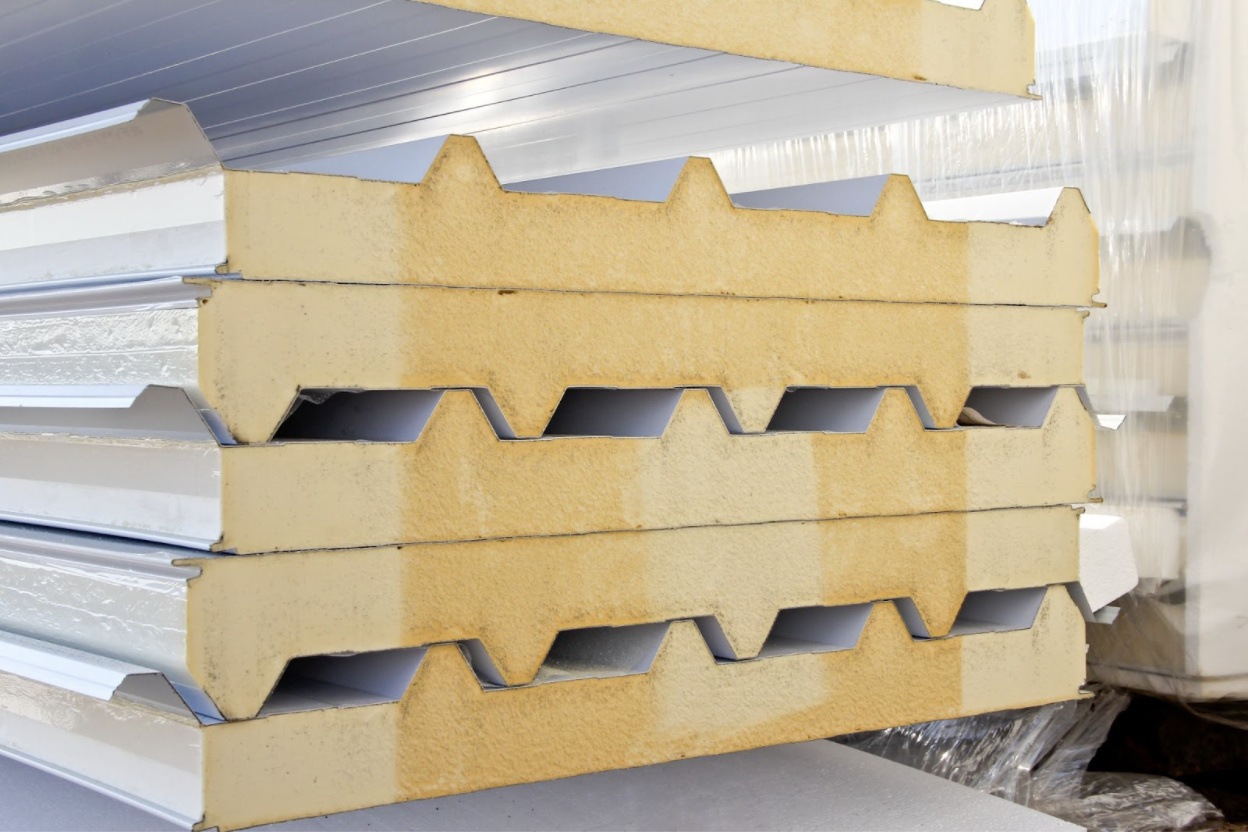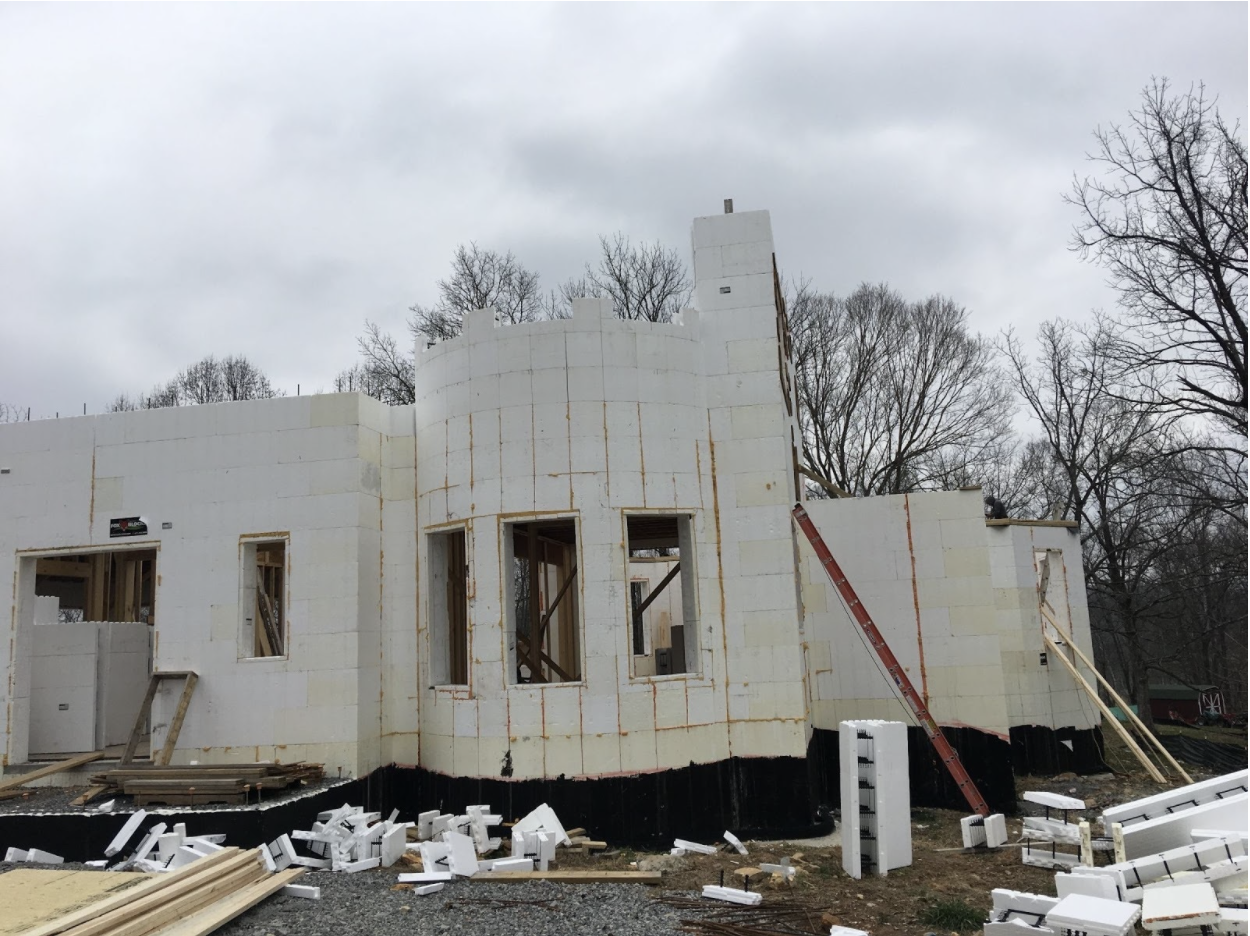
Limitations of Insulated Metal Panels

Contractors have used insulated metal panels (IMPs) for commercial and industrial exterior wall construction for many years, assuming the wall would stop rain, air, and vapor from entering the wall assembly from the outside. However, IMP storage and installation limitations can lead to problems that diminish the effectiveness and success of IMP walls.

IMPs lack adequate sound retention without added paneling, making them less suitable for structures requiring acoustic control.
Fortunately, Fox Blocks insulated concrete forms (ICFs) provide solutions to the limitations of IMPs. Quick and easy to assemble, durable ICFs create a tight building envelope that protects against moisture intrusion and potential mold and corrosion. Fox Blocks achieve a high STC of 50, compatible with LEED certifications.
What Are Insulated Metal Panels?
Insulated metal wall panels include an insulated foam core that is sandwiched between two stabilizers (corrugated, polyallomer, or exterior-grade hardboard) and finished aluminum sheets. The type of stabilizer depends on the climate. High-density, impact-resistant hardboard stabilizers require proper sealing because they can absorb water, which can lead to bulging, corrosion, and diminished R-value of the wall system.
IMP Storage and Installation Limitations
Sloppy storage and improper detailing and installation can cause water infiltration and condensation within the IMP system before, during, and after installation. Water infiltration can lead to damaging mold, swelling walls, and destructive corrosion.
Costly corrosion occurs when water (a corrosive electrolyte) combines with oxygen on two metal surfaces, prompting an electrical connection between the metal surfaces. Corrosion diminishes a structure's integrity and lessens its R-value (energy-efficiency).
Three Storage Limitations with IMPs
Maintaining the integrity of the IMPs requires careful storage, with particular care not to damage the panel’s rust-resistant coating. Damaged panels cost time and money because you must replace damaged panels before beginning construction.
- Panels may get damaged during transportation. Before installing, look for signs of a compromised panel finish, like black discoloration and rust.
- Panels may rust if not correctly stored. If storing outdoors, always tarp panels to resist heavy moisture concentrations from rain and snow.
- To avoid moisture build-up and contact, store the panels so that any water drains, avoiding becoming trapped between panels.
Eight Installation Limitations with IMP
IMPs require manufacturer-recommended installation to prevent water intrusion and preserve the integrity of the entire panel wall system. Improper IMP installation will lead to corrosion and damaged panels, requiring panel replacement or the whole rebuilding of the project.
- The installation of IMP requires drilling that generates uncoated, non-rust-resistant metal shavings. The shavings will cling to the sheeting, quickly leading to rust and staining of the wall panels.
- Writing on IMP with a pencil (containing corrosive graphite) will break down the protective layer, leading to corrosion.
- Spray from adjacent wall coatings, finished systems like Stucco, or similar masonry products can damage IMPs if not immediately removed.
- Direct contact of IMPs with dissimilar/corrosive materials like concrete can diminish the integrity of the panel.
- Without a sufficient gap between the wall panel and the base, the panel may come in contact with corrosive materials, and water can build up.
- Moisture in the air can travel through seams, joints, or gaps between IMPs or the panels and the structural steel, condensing on the interior wall system, leading to several problems:
- The condensed moisture can rust, stain, and deteriorate the unprotected edges of metal.
- Moisture that works its way inside a panel can become trapped, freezing in the cold, which can cause the panels to bow.
- Vertically installed, long-length IMPs require two forklifts to unload and special lifting equipment to install. Without the proper equipment, crews often damage the IMPs, leading to cost and time overruns.
- A proper alignment of the IMPs will ensure the panel’s efficiency and performance. Misalignments, creases, or buckles on the panel’s face will lead to failing panels, requiring a new product or second installation.
Avoid IMP Limitations with Fox Blocks Insulated Concrete Forms
Durable and straightforward to install, Fox Blocks ICFs avoid the storage and installation limitations of IMPs.
Durable ICFs Maintain Their Integrity Before, During, and After Installation
Sturdy, long-lasting Fox Blocks, with an R-value of 23, provide a solid continuous monolithic concrete wall with a perm rating of less than 1.0. Fox Blocks create a tight, durable building envelope that limits air and moisture inflation to the wall system, preventing condensation that can lead to mold and prohibiting damaging corrosion.
Easy to Install ICFs Limit Installation Problems
Modular, flexible, and easy to install, Fox Blocks is an all-in-one wall system that combines five-building steps into one; vapor retarder, air barrier, structure, insulation, air barrier, and attachment. This feature dramatically accelerates project delivery to successfully construct high-performing buildings with less labor, equipment, and installation problems than other framing methods.
Acoustic Limitations with IMP
Major manufacturers of insulated metal panels report a sound transmission coefficient (STC) of 26 to 30 when tested in accordance with ASTM. At an additional cost, they also offer specialized inserts to enhance the STC to 32-43.
Background noise can significantly diminish workers, students, and others comfort and productivity, making IMP less suitable for buildings requiring controlled acoustics like schools, hospitals, office buildings, etc. To obtain a LEED® Indoor Environmental Quality (IEQ) point for enhanced acoustic performance in schools, a building’s shell, interior classroom walls, and other core learning spaces must meet an STC of at least 50, with windows STC of at least 35. In addition, the building’s design must also lessen the background noise level from HVAC systems in classrooms and other core learning spaces to 40 dB or less.
Fox Blocks ICFs Provide Superior Sound Retention Over IMP
Fox Blocks ICF better controls noise between rooms and from the outside compared to IMPs. Sound transmission tests found that less than a thirdof sound passes through ICF walls than ordinary framed walls filled with fiberglass insulation. Fox Blocks achieve a Sound Transmission Classification (ASTM E90) of 4-inch=STC 46, 6- and 8-inch = STC 50+, compliant with LEED certification, and with the addition of extra inserts or panels, unlike IMPs.

Why Choose Fox Blocks ICFs Over IMP?
IMPs’ long-term integrity and energy efficiency depend significantly on proper storage and installation in order not to damage the product. Compromised IMPs allow water to infiltrate, leading to swelling walls, damaging mold, and corrosion. Fortunately, Fox Blocks ICF gives builders a way to avoid the many limitations of IMPs.
Durable, Fox Blocks ICFs provide a simple, effective way to build an airtight, moisture-resistant, energy-efficient wall system that protects the structure's integrity for its lifespan.
In addition, unlike IMPs, Fox Blocks create quiet, acoustically comfortable buildings, essential for schools, hospitals, office buildings, and homes.
For more on avoiding the limitations of insulated metal panels, contact the professionals at Fox Blocks today.